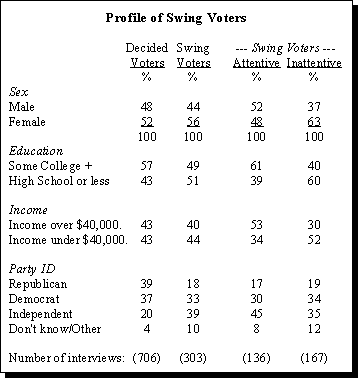 As the presidential campaign moves into the home stretch, two distinctly different groups of swing voters may well determine the outcome. Attentive swing voters — those who have followed the campaign relatively closely and are just as likely to vote as those who have made up their minds — currently favor Al Gore and strongly prefer the vice president’s issue positions. Inattentive swing voters, by contrast, are less interested in the election and less likely to go to the polls. And this group, 63% of whom are women, is evenly divided between the candidates.
As the presidential campaign moves into the home stretch, two distinctly different groups of swing voters may well determine the outcome. Attentive swing voters — those who have followed the campaign relatively closely and are just as likely to vote as those who have made up their minds — currently favor Al Gore and strongly prefer the vice president’s issue positions. Inattentive swing voters, by contrast, are less interested in the election and less likely to go to the polls. And this group, 63% of whom are women, is evenly divided between the candidates.
 The seesaw race between Al Gore and George W. Bush has cast a spotlight on the sizable number of voters still up for grabs — about 30% are either truly undecided or support a candidate but have indicated they could change their minds before Nov. 7. Overall, these swing voters prefer Gore to Bush by 37%-28%, with Ralph Nader drawing 9%.(1)
The seesaw race between Al Gore and George W. Bush has cast a spotlight on the sizable number of voters still up for grabs — about 30% are either truly undecided or support a candidate but have indicated they could change their minds before Nov. 7. Overall, these swing voters prefer Gore to Bush by 37%-28%, with Ralph Nader drawing 9%.(1)
[NOTE: (1)Swing voters, who make up 31% of registered voters, include undecided voters and supporters of candidates who say there is still a chance they might switch their vote. Attentiveness to the campaign is measured using an index based on how much people have heard or read about various campaign events and how much thought they have given to the campaign. Attentive voters are defined as those who have heard “a lot” about three or more items on the ten item index. Data from the Pew Research Center October 4-8 poll of 1009 registered voters. The statistical margin of error is ±3.5% for all registered voters, ±4% for decided voters, ±6.5% for all swing voters, and ±9.5% for attentive and inattentive subgroups.] But Gore’s lead among swing voters may not be good news for the vice president. It arises partly from the fact that his support is less solid than the Texas governor’s at this late stage in the campaign. Fully 26% of Gore supporters haven’t ruled out switching to Bush (19% say they might switch and 7% don’t know), while 20% of Bush supporters say the same about shifting to Gore. And while 46% of independents are undecided or could still change their minds, more than one-quarter of Democrats (28%) are also still in play, compared to just 17% of Republicans.
But Gore’s lead among swing voters may not be good news for the vice president. It arises partly from the fact that his support is less solid than the Texas governor’s at this late stage in the campaign. Fully 26% of Gore supporters haven’t ruled out switching to Bush (19% say they might switch and 7% don’t know), while 20% of Bush supporters say the same about shifting to Gore. And while 46% of independents are undecided or could still change their minds, more than one-quarter of Democrats (28%) are also still in play, compared to just 17% of Republicans.
Comparing the two groups, attentive swing voters tend to be better educated and have higher incomes than those who are less interested in the campaign. Minorities make up a slightly larger percentage of inattentive swing voters, as do unmarried people. In terms of evaluating the candidates, swing voters generally favor Gore over Bush on character traits and issues, but there are significant differences between the attentive and the inattentive.
For instance, engaged swing voters favor Gore by large margins on all major issues, while those less interested in the campaign are closely divided and more likely to say they simply don’t know which candidate would do a better job. Fully six-in-ten (62%) engaged swing voters say Gore would do a better job of improving education, while only 20% opt for Bush. Disengaged swing voters are split (31% choose Gore, 33% say Bush), while 30% don’t know who would do better. Similar patterns are evident on health care, abortion, taxes, Social Security and other major issues.
Fully 46% of swing voters say Gore would use a good judgment in a crisis, while just 21% choose Gore. Gore has strong leads on questions relating to qualifications, leadership and as the candidate who cares about ordinary people. Here there is no significant difference between the engaged and disengaged — greater numbers in both groups favor the vice president on these personal characteristics.


